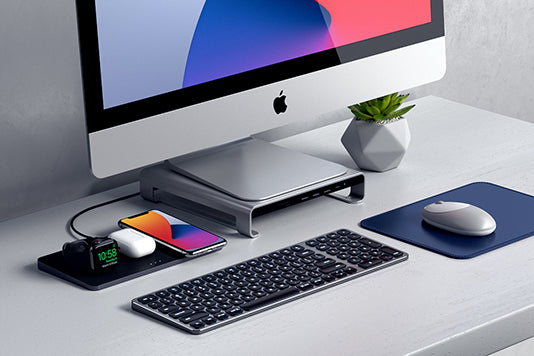The Future of Thunderbolt 3 - Does It Even Have One?

(Image Credits: Kevin Krewell / EET Asia)
Apple has always been a game-changer in the tech industry, a juggernaut that upends the status quo and changes the way we see tech. With their latest innovations, it seems that the future of Thunderbolt 3 is now coming into question. As this new technology evolves, there are a lot of questions being raised about Thunderbolt 3 support & Thunderbolt USB support and what that might look like in the future. Apple & Intel have successfully partnered together for many years to develop and improve the Thunderbolt technology, but that chapter has now concluded as Apple transitions its product lines away from Thunderbolt.
The background of Thunderbolt 3
Apple and Thunderbolt have a long history together. Before Thunderbolt entered the tech field, the USB was the foundation for it all. For reference, there are two general categories for multi-purpose connections: The USB and Thunderbolt, and both operate differently.
Although commonly used, the term USB-C by itself may not mean as much when it comes to data and charging, but the evolution of the USB itself has been pivotal for the USB-C connector.
At its core, the USB was designed to be a standardized tool used across different devices. As the USBs evolved and took various forms, the aim was to improve its speed.
The Thunderbolt was introduced as a joint venture between Apple and Intel, meant to serve as an alternative to USB that could handle up to six devices. As the Thunderbolt evolved, its bandwidth increased - particularly with the introduction of Thunderbolt 3. The Thunderbolt 3 included compatibility with USB-C and Thunderbolt USB support.
Thunderbolt 3 and its compatibility with USB-C enabled the Thunderbolt 3 devices to increase power delivery capabilities and improved users’ overall experience. However, with Intel’s introduction of Thunderbolt 4, new changes are brewing for Thunderbolt USB 4 compatibility. Thunderbolt 4 offers improved support compared to Thunderbolt 3, including increased support and increased data transfers.
An important distinction to note, however, before moving forward is that while all Thunderbolt 3 ports support USB-C ports, not all USB-C ports support Thunderbolt 3 ports. This is often a source of confusion for many, and while there have been attempts to make Thunderbolt 3 the new standard, USB continues to be a popular choice.
Thunderbolt has remained popular because it’s simple and easy to use. It offers fast data transfer and tends to provide a consistent experience for users. While the technology does continue to evolve, questions are being raised about the future of Thunderbolt 3. With Apple’s latest news, Thunderbolt 3 and its compatibility with USB-C and Thunderbolt 3’s USB compatibility may not last long.
The future of Thunderbolt 3
As Thunderbolt 4 remains on the horizon, there have been doubts about the future of Thunderbolt 3. Apple recently announced that they would stop using Intel’s chipsets and use new, custom-designed ARM chips instead. Apple has now brought their ARM chips to market for the first time and they are powering the M1 Macs. A major blow to Intel, there has been worry about what Thunderbolt 3 support would look like moving forward for Apple products.
However, Apple has stated that there is no reason to worry about Thunderbolt 3 compatibility with USB-C or Thunderbolt USB support, at least for the time being. Apple has pledged to continue to provide Thunderbolt 3 support in Apple devices in the future, as a nod to the partnership established by Apple and Intel.
However, Thunderbolt 3 USB support and Thunderbolt 3 USB compatibility are only offered in Intel-powered Apple devices. As the company transitions towards ARM chips, there is continuing worry that Thunderbolt 3 support may not last for too long. Apple has been vague about its plans for the Thunderbolt moving forward, asides from stating it will not abandon the technology completely, at least not yet.
While Apple has said that it intends to support Thunderbolt overall, there has been no mention of whether Thunderbolt 3 or its successor, Thunderbolt 4, would be included in any Apple products offered in the future. Although Intel has promised continuing improvements with the impending release of Thunderbolt 4, there is worry that Apple may eliminate Thunderbolt 3 compatibility with USB-C as Thunderbolt 4 moves away from it. Apple has stated that it plans to transition its product lineup to custom ARM chips within the next two to three years, which makes Thunderbolt 3’s future even more doubtful.
Ultimately, there is no way to know what the future will hold for Thunderbolt as part of Apple products. Apple and Intel have had a long-lasting, successful partnership over the years, and Apple’s role in developing the Thunderbolt technology overall has been instrumental. But as Apple transitions away from Intel chipsets and focuses more on incorporating its custom ARM chips into the product line, Thunderbolt 3 support begins to look weaker and weaker. While it is likely a choice for other technology manufacturers down the line, Apple’s future with Thunderbolt 3 does not look likely.


Leave a Comment